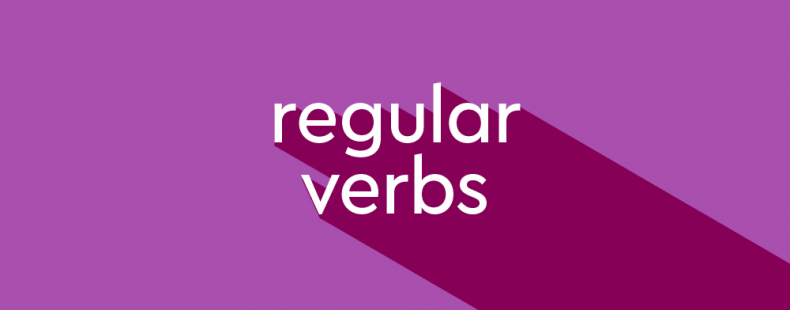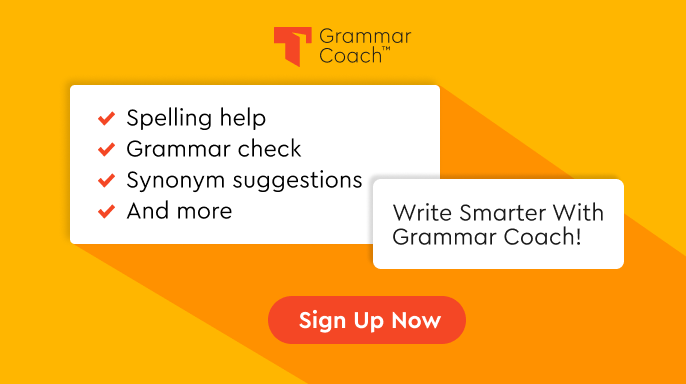Take a minute to think about all of the things you did yesterday. After you woke up, maybe you prepared a delicious breakfast or brushed your teeth. After that, you walked to school or boarded the bus to go to work. Or maybe you stayed home and watched TV or played a video game. At the end of a long day, you turned yourself in for the night and slept comfortably.
Regardless of what you actually did, you would use a certain kind of word to describe all of the actions you performed: verbs. Verbs are all of those exciting words that we use in our sentences to refer to actions or states of being. Every complete sentence that we say or write must have a verb in it, and we use several different types of verbs when we describe the things we do or the states that things are in. Luckily for us, there is a common type of verb that doesn’t try to trick us or make our lives difficult when all we want to do is use correct grammar. (And we say hooray to that!) Regular verbs are happy to follow the rules and don’t cause us trouble. We refer to these friendly verbs as regular verbs.
What is a regular verb?
In grammar, we use the word regular to mean that a part of speech is “conforming to the most prevalent pattern of formation, inflection, construction, etc.” A regular verb is “a verb that follows standard patterns in its inflection.” What does that mean? Well, there are some general rules that we follow in order to use a verb in the simple past tense or to turn it into a past participle. A regular verb cooperates with us and follows these general rules.
These rules are:
1. To form the past tense of a verb, add -ed to the end of the root form of the verb.
- For example, jump becomes jumped and talk becomes talked.
2. If the verb ends in -e, just add a -d to the end of the root form.
- For example, examine becomes examined and dance becomes danced.
3. If the verb ends in -y, we turn the -y into an -i and add -ed.
- For example, cry becomes cried and fry becomes fried.
4. If a one-syllable verb ends in consonant-vowel-consonant, we double the final consonant. However, if the verb ends in -w, -x, or -y, we don’t double the consonant.
- For example, stun becomes stunned and drum becomes drummed.
- For example, skew becomes skewed, box becomes boxed, and stay becomes stayed.
6. If the last syllable of a longer verb is stressed and ends in consonant-vowel-consonant, we double the final consonant. If the last syllable isn’t stressed, then we don’t double the final consonant.
- For example, refer becomes referred and input becomes inputted.
- For example, shovel becomes shoveled and awaken becomes awakened.
There is a special type of regular verb that doesn’t follow these general rules when turned into the simple past tense. Some regular verbs use a –t variant, and they end in -t in the past tense rather than -ed or -d. For example, dream becomes dreamt and leap becomes leapt. Sometimes, -t variant verbs also change their spelling a little bit: for example, send becomes sent and creep becomes crept. Be careful of -t variant verbs, because not all verbs that end in -t in the past tense are regular verbs. For example, the verb catch is NOT a regular verb even though its past tense form caught ends in a -t.
Regardless of whether a regular verb is a -t variant verb or not, its past tense form and past participle will be identical. For example, the past tense of ask is asked and the past participle of ask is also asked. You can see additional examples of this in the following sentences:
- She fished (simple past tense) in the river.
- She had fished (past participle) in the river for a few hours when she caught a salmon.
- Oliver slept (simple past tense) in his tent.
- Oliver has slept (past participle) for hours.
We’ve mostly spoken about the past tense and past participles. But what about present tense and future tense? Because the present and future tenses use the base form of the verb (the form you’ll see listed in a dictionary), most regular and irregular verbs behave the same way. For example, the present tense forms of the regular verb check is check and checks while the future tense form is will check. Even an irregular verb generally follows these rules: for example, the present tense forms of the irregular verb eat is eat and eats, and the future tense form is will eat.
In the present tense, the commonly used verbs be and have don’t follow the rules: the present tense forms of be are is, am, and are, and the present tense forms of have are have and has. In the future tense, even these two verbs follow the rules: the future tense of be is will be and the future tense of have is will have.
Get more insight on the simple future tense here.
List of regular verbs
Most of the verbs you run into will be regular verbs. All of the verbs in the following list, for example, are regular verbs:
- advance, bask, clean, disturb, entertain, focus, grab, hiss, inspect, jingle, knock, listen, memorize, need, open, prepare, quiver, return, study, tickle, uncover, visualize, worry, xerox, yell, zip
Regular verb examples
As far as verbs go, regular verbs are easier to use because they follow the rules and don’t try to trick us. For most regular verbs, simply follow the general rules we mentioned earlier to use them correctly in the simple past tense or to turn them into a past participle. Remember that some regular verbs use the -t variant. There is no general rule that says which regular verbs will use the -t variant, so you’ll just have to learn these tricky verbs as you come across them.
All of the following sentences use regular verbs. As you read each sentence, take note of how all of the verbs follow the general rules of forming simple past tense and past participles.
- Rebecca brushed her cat’s fur.
- The supermodel strutted down the runway.
- Firefighters pried the door open with a crowbar.
- My kids preferred chocolate ice cream over vanilla.
- The beautiful jewelry glistened under the bright lights.
- We spent most of the day at the mall.
- Those loud crows have annoyed me all morning.
- The musician had strummed her guitar for a few minutes before the show started.
- Marco has dreamt about becoming a doctor since he was a boy.
Regular verb rules & best practices
For the most part, you don’t have to worry too much about regular verbs because they follow the general rules mentioned earlier that we use to conjugate verbs. If you are unsure if a verb is a regular verb or not, you can use our amazing dictionary to help guide you. It can be especially helpful to check to see if a particular verb uses the -t variant, as these sly verbs don’t follow the rules exactly despite being regular verbs.
A regular verb is any verb that follows the general rules of conjugating verbs. For this reason, many types of verbs can also be regular verbs. For example, both action verbs and stative verbs can be regular verbs:
- The crowd tossed (action verb) their hats into the air.
- My daughter loved (stative verb) the birthday present I bought for her.
The following sentences contain more examples of different types of verbs that can be regular verbs, too:
- Linking verb: The math problem seemed impossible until my teacher helped me solve it.
- Transitive verb: Steve borrowed my lawnmower for a little while.
- Intransitive verb: We relaxed by the warm fire.
Regular or irregular, your verbs will be correct
You won’t mistake your verb tenses again when you check your writing on Thesaurus.com’s Grammar Coach™. This writing tool uses machine learning technology uniquely designed to catch grammar and spelling errors. Its Synonym Swap will find the best nouns, adjectives, and more to help say what you really mean, guiding you toward clearer, stronger, writing.














